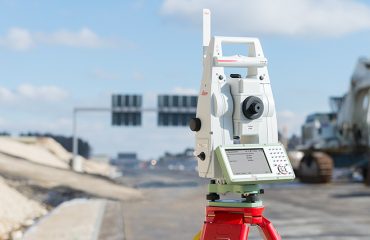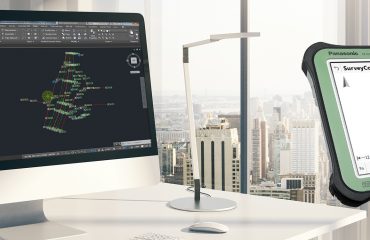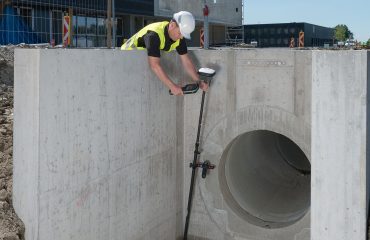Manufactured by Leica Geosystems, a Hexagon company, the new Leica GS18 I smart antenna combines the calibration-free tilt compensation capabilities of the pioneering Leica GS18 T rover with first-of-its-kind survey-grade visual positioning. As a result, GNSS RTK can now be used to measure hundreds of points in minutes, reach previously inaccessible points, and capture points from a safe distance. (Read the Hexagon press release here.)
The GS18 I has the same functionality, look and feel as the popular GS18 T tilt rover but with an extended measurement range and advanced capabilities. Through the sensor fusion of GNSS, an inertial measurement unit (IMU) and a camera, the new instrument captures images that augment the GNSS survey data as a user walks around a structure or area of interest at a regular walking pace. The result is more data captured at survey-grade accuracy with significantly less time on site.
Advantages of Imagery
Bob Kilburn, product and applications manager for Leica Geosystems in the U.S. and Canada, says the ability to immediately visualize what was captured in the field provides a significant benefit. “With the images, you can go through and validate what you captured or missed—you can see what was captured and pull discrete measurement points right from the images,” he explains.
Back in the office, the imagery provides additional advantages. “We’re all familiar with scope creep,” he says. “You come back with the data and then find out the engineer really wanted something else, maybe this façade, or the drip line versus the building edge. You can extract that from the imagery to survey grade without having to go back out to the site, which becomes a huge efficiency gain.”
In addition to surveying, the latest innovation could significantly transform the work done in several other fields that rely on accurate measurement data. In the utility industry, the ability to quickly and accurately map areas that are difficult to reach physically, such as trenches, substations and busy roads, gives service providers greater control over assets while keeping workers out of harm’s way. In public safety, collision investigators could potentially map an entire scene in minutes, enabling a new way to achieve safe, quick clearance. Additionally, applications that have previously been difficult to measure, such as the installation of solar panels on roofs, can now be captured safely and effectively using GNSS RTK with visual positioning.
Real-World Efficiency Gains
Curious about the real-world implications of GNSS RTK with visual positioning, Kilburn and two of his colleagues, Ted Miller and Tim Kerr, are pushing the limits of the GS18 I by taking it out to the field and testing it on applications that would be challenging or impossible for other GNSS rovers. The team presented the results of their analysis in a Q&A webinar. (A PDF summary of the webinar is also available.) But Kilburn encourages anyone who wants to learn more about the new technology to reach out to him or their local rep or dealer anytime.
“This integration of visual positioning with GNSS is something we’ve never seen before,” he says. “Everyone has a lot of questions about what the GS18 I is really capable of doing, and what the best workflows are. We have a lot of those answers already, but we want to keep pushing the envelope. I’m really excited about the efficiency gains we’re seeing with this new solution.”
To talk to one of our experts and learn more about this groundbreaking new solution, please contact us .
Learn More About the New GS18 I GNSS RTK Rover in These Virtual Events



